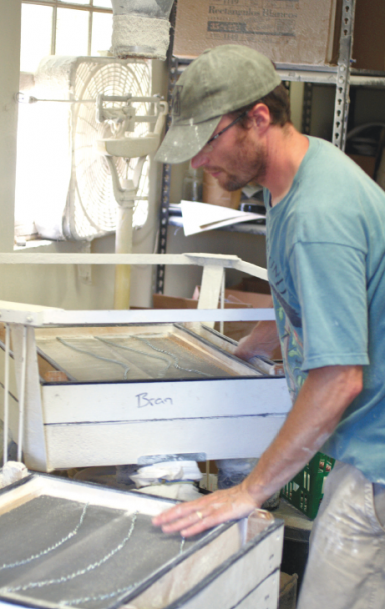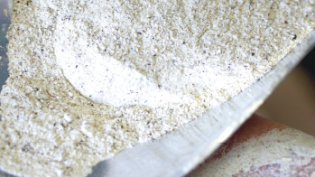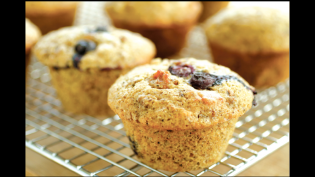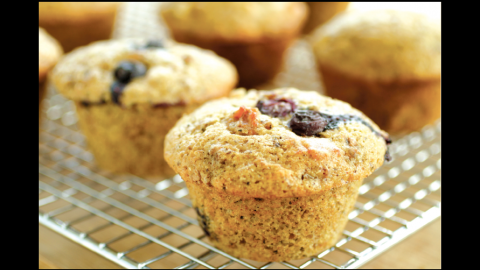In Search of Buckwheat
I have an affinity for mountains. Long before I lived in the Green Mountain State, I spent summer and fall vacations at my family’s cabin in West Virginia, which calls itself the Mountain State. There I acquired a taste for buckwheat pancakes—called “buckwheat cakes” in that part of Appalachia.
When at the cabin, it was the sounds and smells of Grandma making breakfast, infused with notes of West Virginia woods, that lured me from child’s sleep each morning.
Of all the sleep-stopping breakfasts Grandma made at the cabin, her buckwheat pancakes were special: It was only there that would she make them. Denser than regular pancakes, they had a mysterious dark color and a distinctively nutty and pleasantly bitter taste. She purchased buckwheat pancake mix from a local mill—its freshness, she said, made all the difference—and if she didn’t make her batter with buttermilk she would make it with beer, most likely Schlitz or Miller. This, she would divulge to me years later, is the secret to making superior buckwheat pancakes.
Buckwheat is a herbaceous plant related to rhubarb that produces white flours, a favorite of honeybees, and small three-sided seeds that resemble beechnuts. Once hulled and roasted or dried, or ground into flour, buckwheat seeds behave, in culinary terms, like a grain. Thus its confusion-making name, which derives from the Dutch bockweit, literally “beechwheat.”
Though all parts of the buckwheat seed can be used—the dark brown or black hulls are used to fill pillows; the bran, traditionally, as cattle feed—it is the pale inner buckwheat kernel, or groat, that has the most practical uses in the kitchen.
Raw groats have a relatively mild flavor; roasted groats, or kasha, take on a brown color and deep, pronounced flavor. Kasha is available whole and cracked. Unroasted groats are ground into light or dark flour; dark buckwheat flour contains some particles of finely milled hulls, which gives it a more assertive “buckwheat-y” flavor and adds some nutritional value.
Using two buckwheat products—dark buckwheat flour and kasha for an added boost of roasty toasty buckwheat flavor—I set out on a quest: to recreate my memory of Grandma’s buckwheat pancake breakfasts in muffin form.
But Grandma had stressed the importance of using fresh flour. Translation: local flour. Could I find a source of freshly milled, locally grown buckwheat to recreate my memory of Appalachian breakfasts—but with New England terroir? I assumed not. Although suited to cultivation in Vermont, buckwheat has never attained the same significance at the table in New England as it did farther west and south, such as in West Virginia, Pennsylvania or New York. (An exception is northern Maine, where the Acadian French grew, and continue to grow, buckwheat for use in their distinctive, crêpe-like version of buckwheat pancakes called ployes.)
Eventually, however, an online search for Vermont buckwheat proved me wonderfully wrong. Located just two miles from downtown Windsor, off a dirt road, is Green Mountain Flour, a small grist mill and bakery owned by Zach Stremlau and his wife, Daniella Malin. Among their diverse offerings, available as flours, cracked grains, porridges and/or pancake mix, are six grains and a singular seed—buckwheat!
When I visit Green Mountain Flour it is a stifling hot summer day. Heading west from downtown Windsor, the road quickly turns to dirt; a FedEx truck speeds by in the opposite direction, kicking up a wall of dust. I arrive a tad early, and Stremlau is nowhere to be found. His bakery assistant tells me he’ll be back soon; he is picking up a load of wheat from a local farmer.
Wheat is Stremlau’s mainstay grain: He mills 1,000 pounds of it each week to keep up with customer demand and for use in his bakery. Though buckwheat has its devoted following, Stremlau says, the demand for it is much less. In contrast, Stremlau mills an average of 25 pounds of buckwheat per week.
Why not just focus on wheat, the clear cash cow of the group? In short, to keep things interesting for himself, local farmers and his customers.
“I react to what farmers around me, and in the region, are growing,” he explains. “If a farmer would like to grow a particular grain, I’ll buy it and give it try and see if I can use it in the bakery, or see if my customers would like to buy it. Emmer, for example, is a grain that I don’t currently mill. But if farmer called and said, ‘Hey, I’ve got some emmer,’ I’d experiment with it.”
With his mill and bakery, Stremlau hopes he is contributing to the survival of Vermont’s, and New England’s, working landscape.
“One of the reasons I love New England is the patchwork of forest and farm,” he says enthusiastically. “Because I bake in a wood-fired oven, this requires me to buy from both forest and farm, supporting loggers’ and farmers’ livelihoods in a small way.”
Stremlau’s start in bread baking goes back to his youth, when at the age of 15 he worked a summertime job as a dishwasher at Maine coast restaurant. He noticed that the bread the restaurant served was frozen, not fresh. He thought they could do better. After asking his stepmother to show him how to make bread, he made some and brought it to his boss to try.
“I told him he needed fresh bread and I was going to be his baker,” Stremlau recounts. “And he let me do it. He paid me to basically teach myself to make bread. It wasn’t great, but it was better than what they had.”
Some 25-odd years of professional baking and cooking followed, taking him from one coast to another, including a stint of baking at a Buddhist monastery and a temporary detour into farmstead cheesemaking.
From cheesemaking, Stremlau grew to love having a direct connection between the source of the raw ingredient—the cow herd and its milk—and the finished product. He eventually realized that he wanted to translate that experience to breadmaking. For this entrepreneur, starting a milling operation was the next logical step.
“For 15 or 20 years of my baking and cooking career, flour was just a commodity,” he says. “You’d get a bag of white powder or brown powder. Some might be a little coarser, or of varying quality. But other than the name brand, there was no way to know the where or what or why it was processed, or who grew it. With the mill, I get to know the farmer and the grain.”
The mill and bakery share a space in a converted two-car garage just beyond Stremlau’s home. Large bags of grain are stacked shoulder-high along the mill side of the dividing wall, ready to be cracked or ground into flour and sifted. Luckily for me, Stremlau has received a new load of buckwheat that needs to be milled.
Into the hopper go the triangular buckwheat seeds, where they spiral steadily downward to the granite millstones that do the work of grinding. Then, with the assistance of a fan, the whole flour, hulls and all, shoots up and over in a tube to a series of motorized screens that shake jerkily back and forth, mechanically sifting out the hulls while allowing the finer flour to pass through.
It doesn’t take long for the air to be filled with a fine, white powder, giving the room a soft hazy appearance. “Buckwheat is extremely dusty. It gives off a particularly fine and dry, almost chalky-textured powder,” Stremlau explains. He adds that one of the perpetual tasks of the miller is cleaning flour dust.
Stremlau’s milling method—a two-step process of grinding grains or seeds with dressed stones and using a screen or fine cloth to hold back portions of the bran or hulls—is very old-fashioned. Electrical power has replaced mule, water and/or human power to do the grinding and sifting, but other than that, little has changed in this age-old way of turning whole grain into a more easily digestible and versatile form. (The modern form of milling, dating back to the 19th century, is called “roller milling,” named for the large stainless-steel rollers used to crush the grain. It creates a much more refined product than old-fashioned stone milling, and is considered to be less nutritious.)
The fineness of the sifting screen or cloth gives the miller great control over the lightness or darkness of the final flour. After experimenting with different screens, Stremlau settled on one that allows about 3% of the buckwheat hulls to make it into the flour, adding handsome granite-like specks and just the right amount of the bitter buckwheat-y flavor.
As Stremlau handed me a brown flour sack sealed at the top with sewn string, I felt an immense sense of satisfaction, knowing I’d purchased something so close to the source. “It doesn’t get any fresher than this,” I said, grinning. He acknowledged my obvious statement with a knowing smile, a smile of someone who has seen that look of delight on a customer’s face before.
Racing home with my bag of buckwheat flour to make muffins, I thought what Stremlau had told me as we sat talking around his kitchen table—why freshness matters. Just like whole spices versus ground, once ground, flour will begin to quickly stale. Natural oils will eventually go rancid and healthful enzymes and other nutritional components, like vitamins, will, through oxidation, deteriorate.
Now I know why Grandma stressed using fresh buckwheat flour, and why it will make not just the best tasting, but also the best-for-me, buckwheat pancake muffins. And those 3% of hulls Stremlau leaves in the flour? It will add beautiful granite-like specks to each muffin.
Buckwheat: A Great Way to Start the Day
Buckwheat has some star breakfast qualities: It is an excellent source of complex carbohydrates—the type that supplies steady energy to the body—and is high in soluble fiber, which helps to slow down the rate of glucose absorption. In addition, it has a high proportion of all essential amino acids (eight proteins that the body cannot manufacture but are essential to good health), making it a complete protein, a rare status in the plant kingdom shared only by quinoa, amaranth and soybeans. A significant source of minerals, B-complex vitamins and the amino acid lysine, which is uncommon in most cereal grains, it also has high levels of rutin, an antioxidant that can improve blood circulation. And it’s been proven in studies to lower bad cholesterol.
Were this not enough, buckwheat is gluten-free, making it an invaluable pseudo-grain breakfast choice for the gluten-intolerant and those with celiac disease. (Make sure to buy “pure buckwheat,” as sometimes buckwheat flours or pancake mixes may have other flours added, and be sure to buy flour labeled “gluten-free.”)
Sourcing Buckwheat
Zach Stremlau, owner of Green Mountain Flour, sources grain, organic ideally, from farmers as close to home as possible, but considers all of New England to be his sourcing region. To date, his most reliable source for buckwheat is a farm in Massachusetts, but he’s always on the look-out for closer sources.
For retail consumers, the process of finding buckwheat products is a bit more straightforward. You may purchase Green Mountain Flour’s buckwheat products—dark buckwheat flour (in five- and 25-pound bags) and buckwheat pancake mix (made with a blend of GMF’s buckwheat flour and wheat flour)—at stores in the Upper Valley and at drop-off sites. (Visit GreenMountainFlour.com for specific locations.) Note: GMF’s buckwheat flour is not gluten-free because wheat is milled on site. Packaged brands of buckwheat products, such as Bob’s Red Mill, can be found at food co-ops and natural foods stores in Vermont. Buckwheat products are also sometimes available in the bulk departments of food co-ops.











